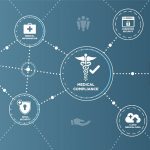
Good communication and interoperability remain at the heart of problem-solving for any industry, and the Medical Fraternity is no exception. The biggest challenge which the healthcare industry faces today is the standardization of information and consistency across different processes. This has given rise
to various organizations and processes, dedicated towards building robust electronic communication platforms and improved healthcare systems interoperability.
Fast Healthcare Interoperability Resources (FHIR, pronounced fire) is a next-generation healthcare processing framework, created by Health Level Seven International (HL7) healthcare standards organization, to achieve smooth healthcare systems interoperability. FHIR is an amalgamation and further improvement of their previous HL7 v.2 and HL7 v.3.For years now, HL7 messaging standards have been widely implemented by the healthcare fraternity on a global level. At Vatsa, we build HL7 standards-based platforms for simplified care.
The Inception of FHIR:
The broad variety of healthcare processes brought about the challenge of standardization of electronic health records (EHR). The goal was to develop a single platform which enabled medical and healthcare applications to be written once and run unmodified across all the other healthcare IT systems. Companies tried to achieve this feat through partial upgrades of their existing softwares and customized solutions. But it did not have any influential effects.
FHIR introduced a standardized, readily acceptable framework which could be adapted by existing processes. Based on the modern web-based suite of Application Programming Interface (API), HL7 is available as a RESTful API, which found ready acceptance from tech-organizations like Facebook, Google, etc. As an example of its wide application, Mirth Connect (now called Nextgen Connect) was a connector that was developed using the HL7-compatible APIs that we used at Vatsa to develop an integration engine for healthcare platform with EHR system. Using the process of Substitutable Medical Applications and Reusable Technologies (abbr. SMART) on FHIR, a synchronous interoperable platform came into existence across different healthcare APIs, web services, cloud-based platforms, third-party apps, Enterprise Service Bus (ESB) and healthcare-related IT products and services.
How it Works:
FHIR defines the standards for data transfer for healthcare service providers and organizations. The framework is built around resources – basic units of data interoperability and lucid expression of meaning, stated in terms of well-defined fields and data types.
FHIR uses the contemporary APIs and Cloud technology, including the HTTP-based RESTful, HTML and Cascading style sheets for user-interface integration. The base standards for data representation can be XML, JSON or RDF. It has resources standardized for all administrative principles like healthcare organization, patients, hospitals, vendors and providers, as well as a variety of standardizations for clinical concepts, like ailments, medication, treatment, diagnosis, financial assistance, etc.
The Advantages:
FHIR outweighs the current standardization procedures set by HL7, namely their version 2 and version 3, and makes use of a more user-friendly system. The problems faced in the current standards, mainly the simplicity of its implementation and data-mining, have been focused on. A few of the advantages of FHIR over the existing standards are as below:
- Simplicity in implementation: FHIR is easy to implement, with multiple implementation libraries having simple interfaces working on a single day.
- Solid foundation in Web-based coding, with JSON, XML, HTTP, etc.
- Support of RESTful architecture
- Includes a human-readable text representation of the data, for clinical safety
- Inherent suitability to mobile devices and tablets, with equal acceptance of android and apple devices.
- Single, globally accepted message standard for international data exchange
FHIR was built to eliminate the challenges faced in the implementation of HL7 v2 and HL7 v3 standardizations. The framework is published as a Standard for Trial use. However, the acceptance of the healthcare IT industries and medical fraternity has been because of its vast advantages and simplicity in using. Though FHIR has been enthusiastically welcomed and shown a promising future to healthcare and medical professionals across the world, it still remains too early to label it as successful. With the constant upgradation of healthcare IT products, adaptability of FHIR across the medical IT processes will remain one of the key factors to measure its acceptance.
Implementation of this technology requires certain know-how, at least during its inception stages. Vatsa Solutions has been at the forefront of helping medical organizations to come up with modernized, result-oriented solutions for interoperability and better management. To know more about how we can help you build a robust healthcare platform, write to us at contact@vsplc.com.
REFERENCE LINKS:
- https://www.hl7.org/fhir/
- https://www.cdisc.org/sites/default/files/resource/Use_of_Fast_Healthcare_Interoperability_Resources_in_the_Generation_of_Real_World_Evidence.pdf
- https://academic.oup.com/jamia/article/23/5/899/2379865
- https://www.researchgate.net/profile/Kamran_Sartipi2/publication/261351945_HL7_FHIR_An_agile_and_RESTful_approach_to_healthcare_information_exchange/links/56e2461f08ae3328e076b8c4/HL7-FHIR-An-agile-and-RESTful-approach-to-healthcare-information-exchange.pdf
- https://en.wikipedia.org/wiki/Fast_Healthcare_Interoperability_Resources





